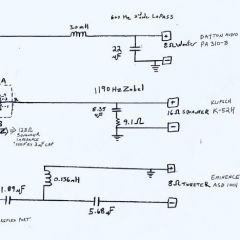Search the Community
Showing results for tags 'slam'.
-
Dear Fellow Klipsch Fans, It has been several years since my original post concerning my Heresy upgrade to achieve smooth midrange, better imaging, and low end slam. I have learned some things since then in living with the mods, researching circuits and, lately, measuring sound. For someone with, at that time, few measuring instruments and so little experience and training in speaker design, I succeeded in voicing my Heresy II's in the right direction for my listening room and the speakers' vertical placement (I had put them on 16" high stands about 16" from each wall in the corners, more later about why this placement was not a good idea). I still believe that polypropylene caps sound better (less harsh) than the original paper-in- oil Aerovox caps; I have yet to measure this however, so I will not be dogmatic, yet. And I am positive that I prefer a poly cap to the electrolytic (33muF woofer) ) that my Heresy's sported from the factory, but they were almost 30 years old (hmmm. . . ) when I replaced them. At the time of my OP I had just discovered poly caps and was quite enthusiastic about them. I mean-I did not think that I should stick each lead of a poly film- and- tin foil cap in either nostril while listening (Nichicon Fine Gold or Elna Silmic II electrolytic with negative lead in left nostril? Hm, probably should use a Nichicon Muse Bipolar. . . ), but better circuit design and speaker placement seem more important. I recently acquired a calibrated measurement microphone (modest, but more precise than my ears) and downloaded some free RTA and room simulation software and decided to experiment with my half-baked, cobbled-together, yet expensive (700W, $50 woofer low-pass coil?) crossover. I have found a cheaper, less invasive, and measurably better modification with remarkable results. The treble and upper midrange are sweet, smooth, and pleasing and blend together seamlessly. Those of you who use mortite on the squawker horns may have been trying for this. The speakers project more like stock , they are more efficient than my previous mod., now 93 dB 2.83 V at I yard @ 1 kHz. The stereo image has depth now as well as width. You can use the original spam can caps if they are still good, but for the woofers, at least buy two 33muF, 100 Volt, Non-Polarized (Bi-Polar) electrolytics if yours are over 20 years old; they are cheap: a buck or two each. Metallized poly propylene 30 muF, 250 Volt caps are available for around $10 each last time I looked. I still like the Eminence ASD 1001 [see my RTA room response of them below] titanium compression drivers I specified in my OP for the tweeters, the four-bolt horns of which need the screw-on adapter plates mentioned in my OP. I cut the phase plugs out of my tweeter horns, but I would try them un-cut.. The Dayton Series II 12" 8-Ohm woofers work well in reproducing down to 30 Hz and their 92 dB sensitivity works with the Klipsch factory squawkers (the best part of the Heresy, IMO); although the -12 dB terminal (#1) of theT2A autoformer needs to be used on the squawker positive instead of terminal #2 on T2A (-9dB) to match output volumes. I checked all three driver relative volumes with calibrated mic and RTA and pink noise source. Also the Eminence tweeter's 2 muF cap needs to be connected directly to the input, completely bypassing the autoformer, whose terminal #3 (-6 dB) originally went to the cap and then from there to tweeter negative, because with my second-order tweeter crossover's smoother transition to the squawker no attenuation is needed to match the squawker output. I leave the woofer crossover totally stock, move the squawker positive to T2A's terminal #1 from T2A's terminal #2, but otherwise leave the squawker crossover alone, bypass T2A entirely for the tweeter, add a 0.25 mH coil across the tweeter terminals to make a 12 dB per octave, 7 kHz high pass filter out of the factory 6 dB/ octave crossover. Also I connect the tweeter in phase with the other two drivers instead of the factory's reverse polarity. Look how flat that tweeter respose is; it goes to almost 19 kHz according to spectrum analysis on white noise, in this room. This curve is of the driver without crossover installed yet. The RTA on pink noise is at 1 octave resolution. Below is a schematic showing the schematic with changes. I put the speakers back on their angled plinths all the way in the corners to avoid midbass suckout at 250 Hz shown in RTA woofer response attached below. The stands I was using and speaker distance from the corners in my listening room dimensions are culprits, since the factory curve for these Dayton woofers shows no such suckout and the crossover does not affect frequencies below 500 Hz. As you can see they go down to 30 Hz very well with no porting necessary. On stands or on the floor, the very bottom octave was little affected. It was the mid bass third octave that was killed by being on the stands. The room simulation software predicted this for my room dimensions, by the way. My previous mod added much mid bass and had a couple large humps across the spectrum, making up perhaps for my misguided use of 16" high stands. More Later. Antone Heresy Crossover.pdf tweeter curve Woofer room response ST305-8_fr.pdf

